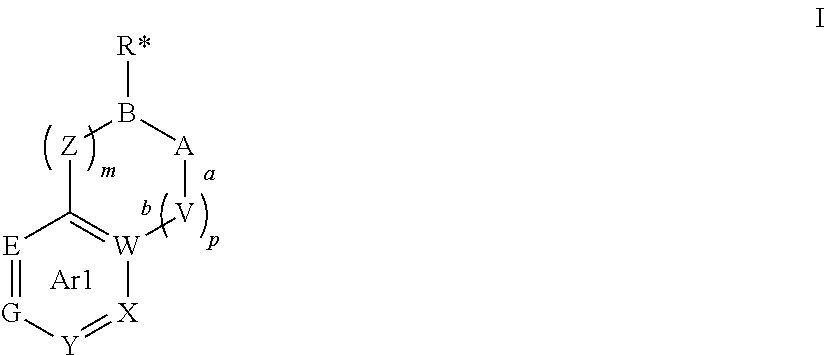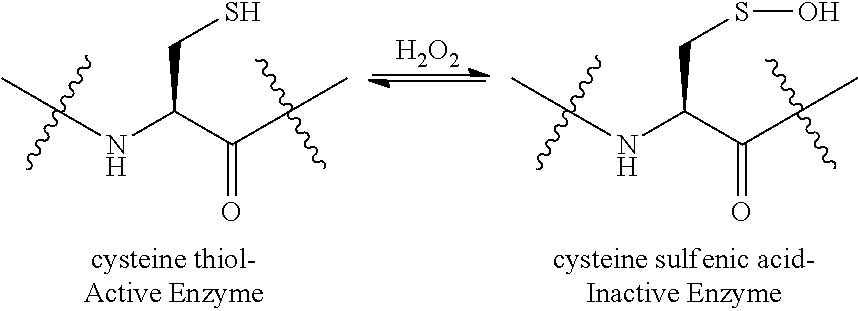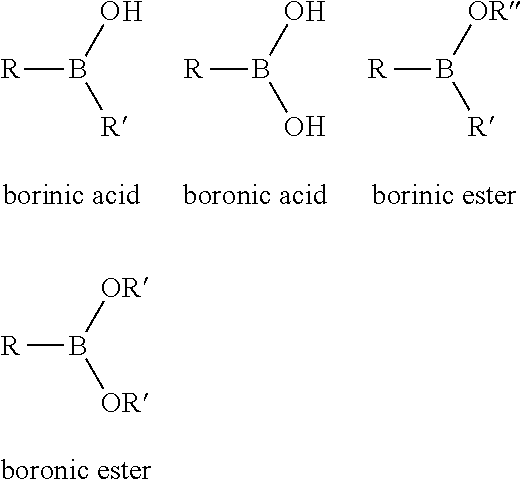Boronic and Borinic Acid Compounds as Inhibitors of Sulfenic Acid-Containing Proteins
a technology of borinic acid and boronic acid, which is applied in the direction of enzymology, chemical treatment enzyme inactivation, lyase, etc., can solve the problems of no reported therapeutics, and achieve the effect of inhibiting the activity of that protein
- Summary
- Abstract
- Description
- Claims
- Application Information
AI Technical Summary
Benefits of technology
Problems solved by technology
Method used
Image
Examples
example 1
Binding Studies
[0145]
[0146]1. Materials
[0147]Reverse-osmosis purified water was further deionized to 18.2 MΩ·cm using a Millipore® filtration apparatus. The double deionized water (ddH2O) was used for all the studies described below.
[0148]1-Chloroanthraqunone (98%), sodium sulfide (anhydrous), bromine (liquid, 99.8%), 2-(hydroxymethyl)benzeneboronic acid hemiester (98+%; 2A), 4-nitrobenzeneboronic acid (95%; 2b), 4-bromo-benzeneboronic acid (97+%; 2e), and 4-fluorobenzene-boronic acid (97%; 2f) were obtained from Alfa Aesar and used without further purification. 3-Bromobenzene-boronic acid (98+%; 2d) and 4-methoxybenzeneboronic acid (98%; 2h) were purchased from Lancaster Synthesis. Sodium hydroxide (≧98%), 200 proof anhydrous ethanol, 5,5-dimethyl-1,3-cyclohexanedione (95%; dimedone), dithiothreitol (DTT), chloroform, 3-nitrobenzeneboronic acid (≧98%; 2c), and phenylboronic acid (95%; 2g) were obtained from Sigma Aldrich. Dimedone was recrystallized from ethanol / water mixture to en...
example 2
Enzymatic Inhibition of Nitrile Hydratase
[0185]Nitrile hydratase (NHase) catalyzes the hydration of nitriles, making it an important industrial enzyme for the production of acrylamide. NHases are metalloenzymes that contain either a non-heme Fe3+ or non-corrin Co3+ in the active site. Mechanistic studies have shown that NHases (from Rhodococcus erythropolis N771) utilize a sulfenic acid moiety, αCys114-SOH, to activate an attacking solvent molecule. [Hashimoto et al., J. Biol. Chem. 2008 283:36617-36623.] The presence of the sulfenic acid is important for the catalysis. The results shown below illustrate that catalytic activity of NHase drops in the presence of boronic acids, exhibiting greater enzymatic inhibition with higher concentrations of boronic acids.
[0186]Here, the catalytic efficiency of the iron-based NHase from Rhodococcus erythropolis AJ270 (purchased from Prozomix Limited, Station court, Haltwhistle, Northumberland, NE49 9HN, UK; see, proxomix.com) was assayed in the p...
PUM
| Property | Measurement | Unit |
|---|---|---|
| pKa | aaaaa | aaaaa |
| volume | aaaaa | aaaaa |
| pKa | aaaaa | aaaaa |
Abstract
Description
Claims
Application Information
 Login to View More
Login to View More - R&D
- Intellectual Property
- Life Sciences
- Materials
- Tech Scout
- Unparalleled Data Quality
- Higher Quality Content
- 60% Fewer Hallucinations
Browse by: Latest US Patents, China's latest patents, Technical Efficacy Thesaurus, Application Domain, Technology Topic, Popular Technical Reports.
© 2025 PatSnap. All rights reserved.Legal|Privacy policy|Modern Slavery Act Transparency Statement|Sitemap|About US| Contact US: help@patsnap.com



